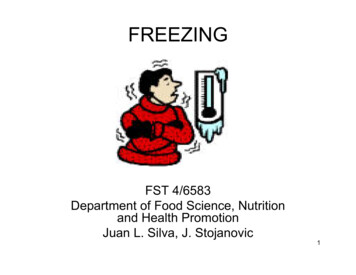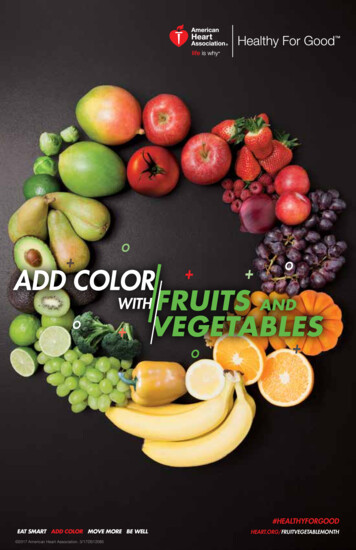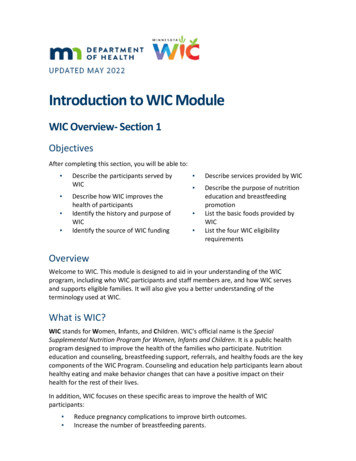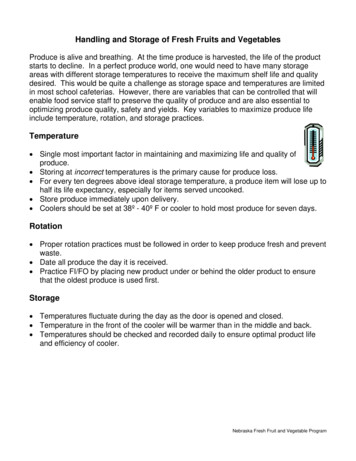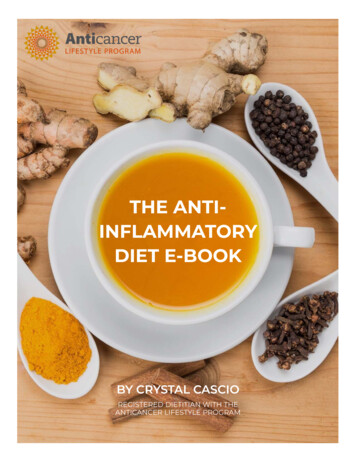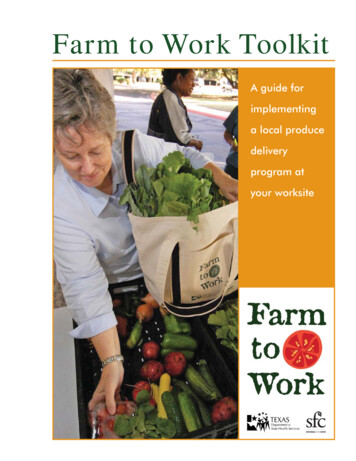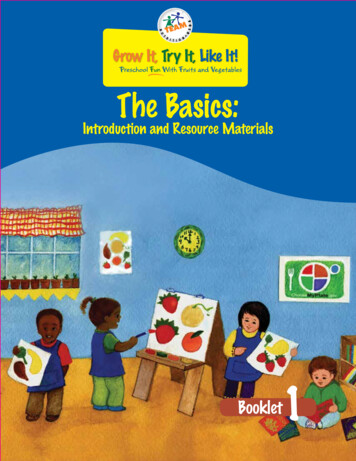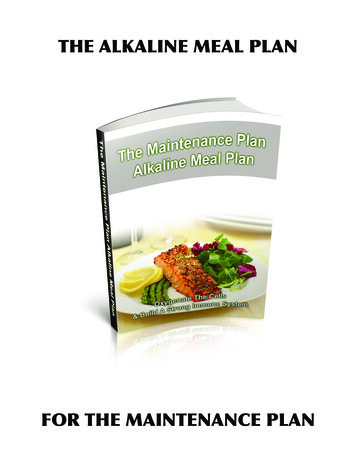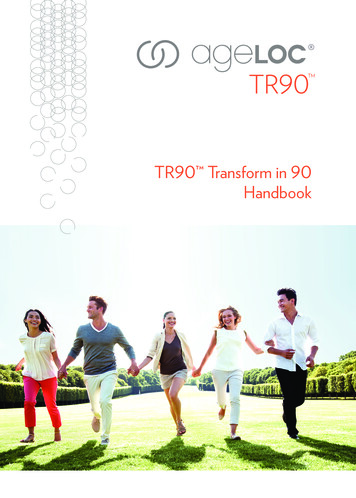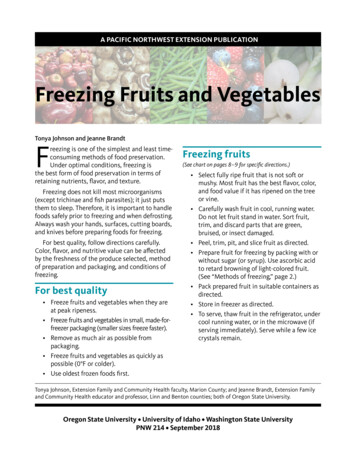
Transcription
A PACIFIC NORTHWEST EXTENSION PUBLICATIONFreezing Fruits and VegetablesTonya Johnson and Jeanne BrandtFreezing is one of the simplest and least timeconsuming methods of food preservation.Under optimal conditions, freezing isthe best form of food preservation in terms ofretaining nutrients, flavor, and texture.Freezing does not kill most microorganisms(except trichinae and fish parasites); it just putsthem to sleep. Therefore, it is important to handlefoods safely prior to freezing and when defrosting.Always wash your hands, surfaces, cutting boards,and knives before preparing foods for freezing.For best quality, follow directions carefully.Color, flavor, and nutritive value can be affectedby the freshness of the produce selected, methodof preparation and packaging, and conditions offreezing.For best quality Freeze fruits and vegetables when they areat peak ripeness. Freeze fruits and vegetables in small, made-forfreezer packaging (smaller sizes freeze faster). Remove as much air as possible frompackaging. Freeze fruits and vegetables as quickly aspossible (0 F or colder). Use oldest frozen foods first.Freezing fruits(See chart on pages 8–9 for specific directions.) Select fully ripe fruit that is not soft ormushy. Most fruit has the best flavor, color,and food value if it has ripened on the treeor vine. Carefully wash fruit in cool, running water.Do not let fruit stand in water. Sort fruit,trim, and discard parts that are green,bruised, or insect damaged. Peel, trim, pit, and slice fruit as directed. Prepare fruit for freezing by packing with orwithout sugar (or syrup). Use ascorbic acidto retard browning of light-colored fruit.(See “Methods of freezing,” page 2.) Pack prepared fruit in suitable containers asdirected. Store in freezer as directed. To serve, thaw fruit in the refrigerator, undercool running water, or in the microwave (ifserving immediately). Serve while a few icecrystals remain.Tonya Johnson, Extension Family and Community Health faculty, Marion County; and Jeanne Brandt, Extension Familyand Community Health educator and professor, Linn and Benton counties; both of Oregon State University.Oregon State University University of Idaho Washington State UniversityPNW 214 September 2018
Methods of freezingWithout sugarAny fruit can be frozen without sugar.However, the texture may be softer than that offruit frozen with sugar.Fruits such as berries, cherries, and grapes maybe frozen in a single layer on cookie sheets beforepacking in containers. This prevents them fromsticking together. Serve them frozen as snacks orthaw and use as a topping for salads or desserts.Prepared fruit bagged for freezing.If desired, a water pack (without sugar) can beused for fruit such as peaches. Fruit juice (eitherextracted from the fruit or purchased) can also beused. Orange, grape, apple, and berry juices aresuitable.Photo by Clare Columbus, Oregon State University.Artificial sweetenersSugar substitutes may be used in any ofthe unsweetened packs. They can be addedprior to freezing or just before serving. Followmanufacturer instructions for the amount to use.Artificial sweeteners give a sweet flavor, but donot provide the benefits that sugar provides infreezing (such as improved texture, color, andthickness of syrup).Syrup packFruits that will be served uncooked are oftenpacked in a sugar syrup. The syrup may beprepared from either cane or beet sugar. If desired,part of the sugar may be replaced by honey. Selectthe strength of syrup that will give the desiredflavor. (This will depend on the sweetness of thefruit, personal preference, and intended use.) Allowabout ⅔ cup of syrup for each pint of fruit and1⅓ cups for each quart of fruit. Dissolve sugar inhot or cold water. If hot, cool before using.Strengthof syrupLightMediumHeavyWater4 cups4 cups4 cupsSugar1 cup1¾ cups2¾ cupsRetarding browningAscorbic acidWhen freezing light-colored fruit, ascorbicacid can be added to inhibit browning. Ascorbicacid in powder or crystal form is often availableat pharmacies and health food stores. Ascorbicacid tablets (vitamin C) can also be used. CrushYield4¾ cups5 cups5½ cupsSugar packJuicy fruits and those that will be used forpies or other cooked products are often packedin sugar. Use about 1 cup of sugar for each 2 to3 pounds of fruit. Sugar and fruit should be gentlybut thoroughly mixed together until the sugar hasdissolved in the juice.Equipment for pretreating fruit.Photo by Clare Columbus, Oregon State University.2
Freezing juicesfinely before use. (Three crushed 500-milligramvitamin C tablets equal ½ teaspoon of ascorbicacid.)A variety of fruit juices can be prepared,including cherry, grape, grapefruit, plum,raspberry, and strawberry. The procedure is similarfor each.For syrup or liquid packs, add ½ teaspoonpowdered or crushed ascorbic acid to each quart(4 cups) of cold syrup. Select fully ripe, good-quality fruit. Rinse and sort in cool, running water. Extract juice by crushing fruit and strainingit through a jelly bag. (Heat fruit slightly tostart the flow of juice if necessary.) A steamjuicer also can be used. Sweeten juice if desired. Pour into freezer containers, allowingadequate headspace. (Refrigerate grapejuice overnight before packing to allowsediment to sink to the bottom. Strainsediment.) Seal and freeze.Tomato juice can be extracted by simmeringquarters or eighths for 5 to 10 minutes. (Skippingthis step causes the juice to separate.) Then pressthrough a sieve or food mill. Season with salt, ifdesired. Pour into containers and freeze.For sugar or sugarless (dry) packs, dissolve½ teaspoon ascorbic acid in 3 tablespoons coldwater and sprinkle over 4 cups of fruit just beforeadding sugar.Commercial antidarkening preparationsFollow manufacturer’s directions forcommercial antidarkening products. Ascorbic acidis the main ingredient in commercial mixturesavailable in most supermarkets.Apple slice treated (left) and untreated (right).Photo by Clare Columbus, Oregon State University.3
Freezing vegetables(See chart, pages 10–14, for specific directions.)Methods of blanching Select top-quality vegetables. If possible,harvest vegetables in the early morningor early evening when it is cool. Preparethem as soon as possible to avoid loss ofquality. If there is a delay, store them in therefrigerator. Wash and sort vegetables in cool, runningwater. Peel, trim, and cut into pieces as directed.Remove damaged pieces.In boiling water Put water in a large kettle with a tight-fittinglid and bring to a rolling boil. (Allow 1 gallonof water for each pound of vegetablesexcept for leafy greens, which require2 gallons per pound.) Put a small quantity of vegetables in awire basket, strainer, or cheesecloth bag.Immerse in boiling water. Cover kettle and boil at top heat for therequired length of time (see chart, pages 10through 14). Begin counting time as soon asthe water returns to a boil. Cool immediately in ice water for the samelength of time used for blanching. Whenthoroughly cool, drain, and pat dry. Packvegetables in freezer bag or container.In steamCut vegetable into pieces. Use a kettle with a tight-fitting lid and abasket that holds the food at least 3 inchesabove the bottom of the kettle. Put 1 to 2 inches of water in a kettle andbring to a rolling boil.Photo by Clare Columbus, Oregon State University. Prepare most vegetables for freezing byblanching. This short heat treatment stopsenzymes that can cause undesirable changesin flavor, texture, color, and nutritivevalue during storage. (See “Methods ofblanching.”) Pack prepared vegetables in suitablecontainers as directed. To serve, submerge frozen vegetables ina small amount of boiling water ( ½ cupper pint). When water returns to full boil,turn heat down to simmer. Cover kettle andcook until tender. Corn on the cob and leafygreens should be partially thawed beforecooking. To cook in a microwave oven, referto the instruction manual. Vegetables that hold up well to cookinggenerally freeze well.Blanching equipment.Photo by Clare Columbus, Oregon State University.4
Put vegetables in a single layer in a steamerbasket or in a colander with legs. Suspendover boiling water. Cover kettle and heat vegetables for therequired length of time. (See chart, pages 10through 14.) Start timing as soon as the lidis on the kettle. Steam blanching times are1½ times boiling-water times. Cool immediately in ice water for the samelength of time used for blanching. Whenthoroughly cool, drain, and pat dry. Packvegetables in a freezer bag or container.1. Vegetable ready to steam.Photo by Clare Columbus, Oregon State University2. Steam for recommended minutes until bright green.Photo by Clare Columbus, Oregon State University3. Cool immediately in ice water.4. Pat dry when thoroughly cooled and drained.5. Vegetable packed in a freezer bag.Photo by Clare Columbus, Oregon State University.Photo by Clare Columbus, Oregon State UniversityPhoto by Clare Columbus, Oregon State University.5
Steps for freezing fruit and vegetablesPacking in containersLabel containers with name of product, type ofpack (for fruit), and date.Food must be packed in suitable containersfor freezing. These containers should be durable,easy to handle, and moisture and vapor resistant.They should also protect foods from absorbingother flavors and colors. Select containers thatwill pack well in the freezer. Smaller containersare best since food will freeze faster and moreevenly. Fruits and vegetables should not be frozenin anything larger than a half-gallon.Loading the freezerFreeze fruits and vegetables as soon as possibleafter they are packed. If there will be a delaybefore freezing, keep packages in the refrigerator.Foods that freeze too slowly may lose qualityor spoil. Only put the amount of unfrozen foodinto a home freezer that will freeze within24 hours. Usually this will be about 2 or 3 poundsof food for each cubic foot of freezer capacity. Forfastest freezing, place packages in a single layeragainst freezing plates or coils. Leave a little spacebetween them so that air can circulate freely.Make sure the packages are completely dry sothey don’t freeze to the freezer. Stack after frozen.Acceptable containers include: Plastic freezer bags (best for dry packs) Vacuum packaging designed for freezing(best for dry packs) Rigid plastic containers (especially good forliquid packs) Glass canning or freezing jars with widemouths (especially good for liquid packs)Pack foods tightly into containers. Allow ampleheadspace between the packed food and the lidto allow room for expansion during freezing. Seetable below.To keep fruit covered with liquid, put acrumpled piece of freezer wrap or waxed paperbetween the fruit and the lid. This will keep thesurface from darkening and drying out.When food is packed in freezer bags, squeezeout as much air as possible. To remove air, twistingfreezer bags can help. There are also commercialproducts that help draw out air. Seal the packagewell.Packing the freezer.Photo by Clare Columbus, Oregon State University.Headspace to allow between packed food and closureType of packContainer with wide top openingContainer with narrow top openingPintQuartPintQuartLiquid pack*½ inch1 inch¾ inch1½ inchDry pack**½ inch½ inch½ inch½ inchJuices1½ inch1½ inch1½ inch1½ inch*Fruit packed in juice, sugar, syrup, or water; crushed or puréed fruit.**Fruit or vegetable packed without added sugar or liquid.6
Storing frozen foodopened. Dry ice can be used to keep foods frozenlonger. If the power will be off for a long periodof time, food should be transferred to a workingfreezer.After freezing, packages may be stored closetogether. Store them at 0 F (-18 C) or below.Foods lose quality and nutritive value muchfaster at higher temperatures. Use a freezerthermometer to monitor the temperature.It is safe to refreeze fruits and vegetables thatstill contain ice crystals. For best quality, refreezefood in small quantities.Most fruits and vegetables maintain high qualityfor 8 to 12 months. (Unsweetened fruits losequality faster than those packed in sugar or syrup.)Storage for longer periods will affect the quality ofthe frozen foods, but they will be safe to eat.If the temperature has warmed above 40 F(5 C), foods may not be safe for refreezing. Checkyour freezer thermometer to determine thetemperature.Refreezing frozen foodsDo not eat thawed vegetables that are above40 F. The low acidity of vegetables makes itpossible for harmful bacteria to grow. Unsafeproducts may not show obvious signs of spoilage.Occasionally a home freezer stops running.The length of time food will stay frozen dependson the amount of food in the freezer and thetemperature of the food. A full load of food willstay frozen for up to 2 days if the freezer is notFor information about the safety of specificfoods, call your local Extension office. Be preparedto give the “history” of the food (length of timethat the power was off and temperature of thefood before the freezer began to run again).Keeping a freezer inventory and datingpackages will help to rotate the supply.7
Freezing fruitsSee pages 1 to 3 for details on packing with or without sugar or syrup. Fruits may also be frozen aspurées and for making jams. For light-colored fruits, use ascorbic acid to prevent browning. Store at 0 F(-18 C) or below for top quality. You can also freeze some fruits such as berries, cherries, and grapes in asingle layer on cookie sheets before packing in containers. This prevents them from sticking together.FruitApplesPreparationSelect crisp, firm fruit (not mealy). Wash, peel, core, and slice. To prevent browning duringpreparation, slice into ascorbic acid solution (3,000 mg ascorbic acid to 1 gallon of water).Drain. Pack in cold syrup, sugar (or artificial sweetener), or without sugar. Syrup pack ispreferred for apples that will be used for uncooked desserts or fruit cocktail. A sugar packis good for making pie.ApplesauceWash apples, peel (if desired), core, and slice. Cook until tender, adding a small amountof water to prevent burning or sticking. Strain through a food mill if desired and mash todesired texture. Sweeten to taste. Cool and pack.ApricotsSelect firm, ripe, uniformly yellow fruit. Wash, halve, and pit. Peel and slice, if desired. Toloosen skins, score skin and dip in boiling water until skin starts to split. If apricots are notpeeled, heat them in boiling water for 30 seconds to keep skins from toughening duringfreezing. Cool in ice water and drain. Pack in syrup or sugar (or artificial sweetener). Useascorbic acid to retard browning.AvocadosBest frozen as purée (not whole or sliced). Select avocados that are soft and with rindsfree from dark blemishes. Wash, peel, halve, and remove pit. Mash the pulp. For betterquality, add ¼ teaspoon of ascorbic acid per quart. Pack without sugar if using for salads,dips, or sandwiches.BananasSelect firm, ripe bananas. Wash, peel, and mash thoroughly. To retard browning, add½ teaspoon (1,500 mg) ascorbic acid per cup of mashed bananas. Bananas can also befrozen in their skin (packed in a freezer container).BlackberriesAlso boysenberries, marionberries and loganberries. Select firm, fully ripe fruit withglossy skins. Wash carefully and drain. Discard any soft, underripe, or defective fruit. Packin syrup, sugar (or artificial sweetener), or without sugar. Blackberries can also be frozenin a single layer on a cookie sheet before packing.BlueberriesAlso huckleberries. Select ripe berries with tender skins. For dry pack without sugar,wash, drain, dry, and pack berries into freezer bags or containers. Blueberries can also befrozen in a single layer on a cookie sheet before packing.Blueberries can also be crushed or puréed, then frozen. Wash berries. Crush by pressingberries through a fine sieve, or purée in a blender or food processor. Mix 1⅛ cups of sugarwith each quart of crushed or puréed berries, if desired. Stir until sugar is dissolved. Packin freezer container.CantaloupeAlso other melons. Select firm, well-colored, ripe melons. Wash skin with vegetable scrubbrush. Cut in half, remove seeds, and peel. Cut into slices, cubes, or balls. Pack in syrup.Cherries, sour Select bright red, tree-ripened fruit. Stem and wash. Drain and pit. Pack in syrup, sugar (orartificial sweetener), or without sugar. Use ascorbic acid to retard browning, if desired.Cherries, sweet Select tree-ripened, deep-colored varieties. Stem and wash. Drain and remove pits ifdesired. Pack in syrup or pack without sugar.CranberriesChoose firm, deep red berries with glossy skins. Stem and sort. Wash and drain. Pack in syrup orwithout sugar. Cranberries can also be frozen in a single layer on a cookie sheet before packing.continued next page8
FruitPreparationCurrantsSelect fully ripe, bright red fruit. Wash and stem. Pack in syrup, sugar (or artificialsweetener), or without sugar.Select dates with good flavor and tender texture. Wash and split to remove pits. Leavewhole or press through a sieve for purée. Pack without sugar.Select tree-ripened, soft, ripe fruit. Wash and cut off stems. Peel, if desired. Slice or leavewhole. Pack in syrup or without sugar. Use ascorbic acid to retard browning.Select fully ripe (for pie) or slightly underripe (for jelly) berries. Wash and remove stemsand blossom ends. Pack without sugar (for use in pies or preserves).Choose fully ripe, firm, sweet grapes. Sort, stem, and wash. Leave seedless grapes whole;cut table grapes with seeds in half and remove seeds. Pack in syrup or pack without sugar.Grapes can also be frozen in a single layer on a cookie sheet before packing.DatesFigsGooseberriesGrapesGrapes can also be puréed. Wash, stem, and crush the grapes. Heat to boiling. Drain offfree juice and freeze it separately. Remove seeds and hulls with a colander. To one quartpurée, add ½ cup sugar. Pack in freezer containers.GrapefruitAlso oranges. Select firm, tree-ripened fruit, heavy for its size and free from soft spots.Wash fruit. Remove all peel, membranes, and seeds. Divide fruit into sections, or slice,if desired. Pack in syrup (made with excess juice and water if needed) or pack in waterwithout sugar.Nectarines and Select firm, fully ripe, well-colored fruit. Handle carefully to avoid bruising. Wash, peel,peachesand remove pit. Cut in halves, quarters, or slices. Pack in syrup, orange juice, waterwithout sugar, or pack dry with sugar (or artificial sweetener). Use ascorbic acid to arbStrawberriesNectarines and peaches can also be frozen crushed or puréed. Coarsely crush peeledand pitted nectarines or peaches. For purée, press through a sieve or purée in blender orfood processor (heating pitted nectarines or peaches for 4 minutes in just enough waterto prevent scorching makes them easier to purée). For better quality, add ⅛ teaspoonascorbic acid to each quart of fruit. Pack into freezer containers.Select well-ripened, firm fruit. Wash and peel. Cut in halves or quarters and remove cores.Heat in boiling syrup for 1 to 2 minutes (depending on size of pieces). Drain, cool, andpack in syrup. Use ascorbic acid to retard browning.Select orange, soft, ripe persimmons. Sort, wash, peel, and cut into sections. Pressfruit through a sieve or blend in a blender to make a purée. To each quart of purée, add⅛ teaspoon ascorbic acid. Purées may be made with or without sugar. Pack in freezercontainers.Also prunes. Select firm, tree-ripened fruit. Wash. Leave whole, or cut in halves orquarters; remove pits. Pack in syrup or without sugar. Use ascorbic acid to retardbrowning.Select fully ripe, juicy berries. (Seedy berries are best for purées or juice.) Wash and drain.Pack in syrup, sugar (or artificial sweetener), or without sugar.Select firm, well-colored stalks with good flavor and few fibers. Wash, trim, and cut into½-inch pieces. Blanching rhubarb in boiling water for 1 minute and cooling promptly in icewater will help retain color and flavor. It can also be frozen raw. Pack in syrup or withoutsugar.Select firm, ripe, red berries. Wash, drain, and remove hulls. Slice, if desired. Pack the fruitalone or with syrup, sugar, or artificial sweetener.9
Freezing vegetablesSee pages 4 to 5 for details on blanching. For blanching in boiling water, begin timing as soon asthe water returns to a boil. For steam blanching, start timing as soon as the lid is on the kettle. Storepackaged vegetables at 0 F (-18 C) or below for top quality.VegetableAsparagusBeans—green(snap or wax)Beans—pinto,lima, or butterBeetsBroccoliBrussel sproutsCarrotsCauliflowerPreparationSelect young stalks with compact tips. Wash and sort bysize. Leave whole or cut in 1- to 2-inch lengths. Blanch,cool, drain, and pack, leaving no headspace.Select young, stringless beans. Wash, snip off tips. Cut orbreak into suitable pieces or slice lengthwise into strips.Blanch, cool, drain, and pack leaving ½-inch headspace.Harvest beans while seeds are green. Wash, shell, and sortaccording to size. Blanch, cool, drain, and package leaving½-inch headspace.Select deep, uniformly red, tender, young beets. Wash andsort by size. Trim tops, leaving ½-inch of stems and tap rootto prevent bleeding of color during cooking. Cook in boilingwater until tender (small beets 25 to 30 minutes; mediumbeets 45 to 50 minutes). Cool promptly in cold water. Peel,remove stem and tap root, and cut into slices or cubes.Package leaving ½-inch headspace.Select firm, young, tender stalks with compact heads. Washand trim leaves and woody ends. If necessary to removeinsects, soak 30 minutes in salt brine (4 teaspoons saltto 1 gallon of water). Rinse and drain. Cut through stalkslengthwise, leaving heads 1 inch in diameter. Blanch,cool, drain, and pack head and stalk ends alternately incontainer. Leave no headspace.Select green, firm, compact heads. Wash and trim outerleaves. Soak 30 minutes in salt brine (see broccoli). Rinseand drain. Blanch, cool, drain, and package leaving noheadspace.Select tender carrots. Remove tops, wash, and peel. Diceor slice lengthwise ¼-inch thick. Blanch, cool, drain, andpackage leaving ½-inch headspace.Select firm, white heads. Wash and trim. Split heads intopieces 1 inch across. If necessary to remove insects, soak30 minutes in salt brine (4 teaspoons salt to 1 gallon ofwater). Rinse and drain. Blanch, cool, drain, and packageleaving ½-inch headspace.Blanching times (minutes)In boiling water In steamSmall stalk2Medium stalk 3Large stalk433565Small2Medium 3Large4Cook356—35Small heads 3Medium heads 4Large heads 5567Small5Diced or sliced 28335continued next page10
VegetableCeleryCorn—on s—freshKohlrabiPreparationCelery loses its crispness when frozen, so it is suitable onlyfor cooked dishes. Select crisp, tender stalks, free fromcoarse strings. Wash thoroughly, trim and cut stalks into1-inch lengths or desired size for cooking. Blanch, cool,drain, and package leaving no headspace.Select ears with plump kernels and thin, sweet milk. Husk,remove silk, and wash. Blanch, cool promptly, and drain.Wrap each ear separately or tightly pack desired number inlarge freezer bags or containers.Select tender, freshly gathered corn in the milk stage. Huskand trim the ears, remove silks, and wash. Blanch, coolpromptly, and drain. Cut kernel tips and scrape the cobswith the back of a knife to remove the juice and the heartof the kernel. Package leaving ½-inch headspace.Blanching times (minutes)In boiling water In steam3—Small7Medium 9Large11Another way to prepare cream-style corn for freezing is tocut and scrape the corn from the cob without blanching.Place the cut corn in a double boiler and heat with constantstirring for about 10 minutes or until it thickens; allow tocool by placing the pan in ice water. Package in moistureand vapor-resistant containers, leaving ½-inch headspace.Select tender, freshly gathered corn in the milk stage.Husk and trim the ears, remove silks, and wash. Blanch,cool promptly, drain, and cut from cob. Cut kernels fromcob about ⅔ the depth of the kernels. Package leaving½-inch headspace.Harvest before seeds become mature and when color isuniformly dark. Wash, peel, and slice ⅓-inch thick. Preparequickly, enough eggplant for one blanch at a time. Blanchin 1 gallon of boiling water containing ½ cup lemon juice.Cool, drain, and package leaving ½-inch headspace.Wash, drain, and pat dry with paper towels. Wrap a fewsprigs or leaves in freezer wrap and place in a freezer bag.Chop and use frozen herbs in cooked dishes.Select stems when fully grown but tender. Cut off topsand roots. Wash and peel off the tough bark. Leave wholeor dice in ½-inch cubes. Blanch, cool, drain, and packageleaving ½-inch inued next page11
Blanching times (minutes)In boiling water In steamVegetablePreparationMushroomsSelect edible mushrooms free of spots or decay. Wash andremove stem base. Freeze small mushrooms whole; cutlarge ones into four or more pieces.Whole 9Buttons 9Slices 5Mushrooms can be steamed or heated in fat in a fry pan.Steamed mushrooms will keep longer than those heated infat.To steam: Mushrooms to be steamed will have bettercolor if first given anti-darkening treatmen. To do this, dipfor 5 minutes in a solution containing 1 teaspoon lemonjuice or 1½ teaspoons citric acid to a pint of water. Thensteam, cool promptly, drain, and package leaving ½-inchheadspace.OnionsPeas—ediblepodTo heat in fry pan: Heat small quantities of mushrooms inmargarine or butter in an open fry pan until almost done.Cool in air or set pan in which mushrooms were cooked incold water. Package leaving ½-inch headspace.Select fully mature onions. Peel and wash. Blanch, cool,3–7drain, and package leaving ½-inch headspace. Onions(including green onions) may also be frozen diced andunblanched.Select young, bright green, flat, tender pods. Wash. Remove Small podsstems, blossom ends, and any strings. Blanch, cool, drain,Large podsand package leaving ½-inch headspace.NOTE: If the peas have started to develop, follow thedirections for green beans. If the peas are alreadydeveloped, shell and follow the directions for green peas.Peas—greenHarvest when pods are filled with young, tender peas thathave not become starchy. Wash and shell. Blanch, cool,drain, and package leaving ½-inch headspace.Peppers—sweet Select crisp, tender, green or bright red peppers. Wash,(green)cut out stems, cut in half, and remove seeds. Slice or dice.Blanch, cool, drain, and package leaving ½-inch headspace.May also be frozen unblanched.Peppers—hotSelect firm, smooth peppers. Wash and dry. Protect hands(green chile)with rubber gloves. Broil for 6 to 8 minutes to loosen skin.(First make a small slit in each to allow steam to escape.)Cool. Remove peel, seeds, and stems before or afterfreezing. Chop if desired. Package leaving no —Hot peppers can also be frozen without heating first. Washand stem peppers. Chop if desired. Package leaving noheadspace.continued next page12
VegetableNew sPreparationSelect smooth new potatoes directly from the garden.Wash and peel or scrape. Blanch, cool, drain, and packageleaving ½-inch headspace.For French fries: Wash, peel, and cut into ⅓-inch stickslengthwise, then crosswise into ⅓-inch strips. Rinse in coldwater. Dry thoroughly. Fry small amounts in deep, hot fat(360 F) about 5 minutes until tender but not brown. Drainon paper towel. Cool. Package leaving no headspace. Toserve, finish browning potatoes in a hot oven (475 F).Select medium to large sweet potatoes. Wash and cookuntil almost tender. Cool. Peel, cut in halves, slice, or mash.To prevent browning, dip sweet potatoes 5 seconds in asolution of ½ cup lemon juice to 1 quart of water. To keepmashed sweet potatoes from darkening, mix 2 tablespoonsorange or lemon juice with each quart of mashed sweetpotatoes. Package leaving ½-inch headspace.Blanching times (minutes)In boiling water In steam3–55–8Cook—Baked: Wash, trim, and bake potatoes (with skin on) in ovenuntil slightly soft. Cool completely, remove peel, and wrapindividually in aluminum foil. Place in freezer bag and freeze.Complete the baking in an oven at 350 F immediatelybefore serving, leaving potatoes wrapped in foil.Also other winter squash. Select full-color, matureCookpumpkin. Wash with vegetable scrub brush. Cut into fairlyuniform pieces. Remove seeds. Cook until soft in oven orpressure cooker, or by steaming. Cool promptly, scoop pulpfrom rind, and mash or put through ricer. Package leaving½-inch headspace.Also other greens. Select young, tender leaves. RemoveCollards 3tough stems. Wash. Blanch, cool, drain, and package leaving Spinach and½-inch headspace.others2Select firm, ripe tomatoes.Cook—53—Raw: Wash and dip in boiling water for 30 seconds toloosen skins. Core and peel. Freeze whole or in pieces.Package leaving 1-inch headspace. Seal and freeze. Useonly for cooking or seasoning as tomatoes will not be solidwhen thawed. Raw tomatoes can also be frozen with skinon.Stewed tomatoes: Remove stem ends, peel, and quarterripe tomatoes. Cover and cook until tender (10 to20 minutes). Place pan containing tomatoes in cold waterto cool. Package leaving headspace (see table on page 6 foramount).Juice: Cut in quarters or eighths. Simmer 5 to 10 minutes.Press through a sieve. If desired, season with 1 teaspoonsalt to each quart of juice. Pour into freezer containersleaving headspace (see table on page 6 for amount).continued next page13
Blanching times (minutes)In boiling water In steamVegetablePreparationTurnips orparsnipsSelect small to medium, firm turnips or parsnips that aretender and have a mild flavor. Wash, peel, and cut into½-inch cubes. Blanch, cool promptly, drain, and packageleaving ½-inch headspace.Also other summer squash. Choose young squash withtender skin. Wash and cut in ½-inch slices. Blanch, c
Freezing juices A variety of fruit juices can be prepared, including cherry, grape, grapefruit, plum, raspberry, and strawberry. The procedure is similar for each. Select fully ripe, good-quality fruit. Rinse and sort in cool, running water. Extract juice by crushing fruit and straining it thro

